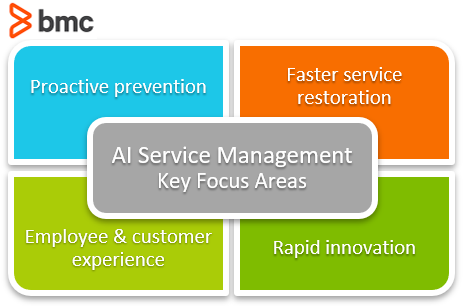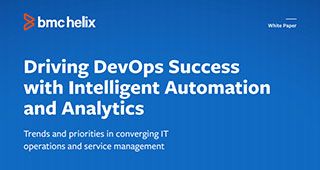According to IDC, enterprises will need to deliver more services in the next four years than they have in the previous 40 years.[1] That’s no surprise: digital success today hinges on an organization’s ability to deliver:
- Rapid innovation
- Exceptional customer experiences
To meet the quality, velocity, and sheer scale of these innovations, enterprises are rethinking the way they deliver and manage those services. Simply put, human effort and manual processes will never scale to the level needed to meet modern business requirements. It’s time to put AI to work.
So, let’s talk about AI-powered service management (AISM) and what it means for enterprises today.

How AI service management works
AISM is the application of artificial intelligence (AI) to service management, sometimes known as ITSM. Other terms include AI-powered service management or simply AI service management. AISM is an emerging approach that aims to solve the increasing challenges of traditional IT service management, as we’ll see below. In contrast to traditional ITSM, AISM is focused on:
- Proactive prevention
- Faster restoration of services
- Rapid innovation
- A fanatical focus on the employee and customer experience
How can you make all this possible? A well-designed application of AI and machine learning (ML) can surface insights from large volumes of data that people would otherwise be unable to use effectively.
An AISM solution helps enterprises meet expectations for a fast, accurate, and scalable service experience by providing a unified, open platform for AI-driven automated actions and workflows complemented by cross-domain visibility and operability.
(See the differences between AI & ML.)
Challenges of traditional service management
The digital era has shone a harsh light on the limitations of traditional service management—especially ITSM. Manual processes create bottlenecks and can’t scale to deliver the agility to be successful in the market.
As incidents occur, traditional methods mean teams fall back on tribal knowledge and educated guesses to identify the underlying problems, understand their business impact, and determine the best way forward. In the best cases, the organization relies on “heroes”—those handful of staffers with the right experience and the right instincts to perform the required miracles and restore service.
It goes without saying that this approach is fundamentally unscalable and tenuous. Most often, organizations become completely reactive, with never enough time to analyze and solve root causes and end up restoring service for the same issues over and over. And the more complex the environment? The more reactive it gets.
To deliver the service excellence needed for digital success today, organizations must evolve from dependence on heroes and serial processes that that leave it mostly reactive, to a new approach—AISM.
The importance of AISM
Digital transformation isn’t a new concept, and it’s no longer an aspirational goal. The ability to operationalize and rapidly expand digital transformation has become a baseline competitive requirement for every enterprise. That means delivering consumer-grade experiences for employees and customers alike, with the ease of use, reliability, and performance people have come to expect from the best technology companies.
Today, nearly every company is a technology company—regardless of the industry, product, or service they sell. In all types of business and consumer markets, creating and delivering high quality, compelling service innovations has become an essential core competency.
- SaaS and cloud strategy are focused on getting new products to market faster, in addition to the inherent benefits of cost optimization and scale.
- Along with this high-velocity innovation, users place a premium on the experience as well.
However, the speed of digital change also drives new levels of risk. As companies embrace more agile approaches to innovation such as DevOps, the resulting topology—a complex landscape of ever-shifting interdependencies with ephemeral components—is simply too overwhelming for traditional operational paradigms.
When it’s impossible for even the most experienced staffer to maintain a full understanding of the environment at a given moment, a new approach to balancing change and risk is needed.
AISM use cases
In 2021, intelligent automation is a top priority for 75% of enterprises.[2] A growing consensus expects that digital experience will be only be compelling, but measurably so. According to Gartner®, “By 2025, 70% of digital business initiatives will require I&O leaders to report on business metrics from digital experience,[3] up from less than 15% today.”
For example, not long ago, chatbots designed with minimal capabilities were seen as a state-of-the-art. With advancements in conversational AI, chatbots are better able to understand language context and extend their capabilities through machine learning requiring less upfront training than the chatbots from just a few years ago.
More than just a new user interface, the chatbot becomes an end-to-end experience that dynamically delivers the customized information people need to maximize productivity. Contextual understanding and natural language processing (NLP) help virtual agents provide faster, more accurate answers than first-generation chatbots—a wholly improved customer experience.
(Explore enterprise chatbot best practices.)
Key use cases for AISM include:

Intelligent service automation
Going beyond low-level task automation, AISM takes on higher-order processes such as:
- Finding patterns in aggregated data
- Leveraging advanced analytics for constant improvement
- Performing incident analysis and root cause analysis to shorten investigative time and MTTR
AI can make self-service faster and more accurate while improving the speed and efficiency of service desk staffers.
(See how AISM delivers 361% ROI for service desks.)
Core enterprise service management
As enterprises seek to expand service management capabilities and learnings beyond IT by taking a shared services approach across HR, facilities, and other lines of business, AI/ML benefits can be applied in these areas as well an approach known as enterprise service management.
By capturing up-to-date, relevant knowledge and making it more easily usable through intelligent interfaces and natural language processing, AISM can help enterprises realize their ever-elusive goals in knowledge management.
Enabling agile DevOps success
AI service management is also a key enabler for organizations that are compelled to innovate faster and deliver more features to employees and customers just to stay competitive. Other areas also benefit from the data insights and automation that an AISM strategy delivers, especially the rise of DevOps, including:
AISM makes it possible to deliver new services faster with automated deployment, and to leverage advanced analytics for anomaly detection, correlation, and predictive trends to optimize service quality and availability. This AI intelligence can be incorporated into modern service support models such as incident swarming to drive better MTTI/MTTR for traditional IT Ops, DevOps, and line of business (LOB) service owners alike.
AISM enables a smarter, faster future for IT, users & customers
The speed and scale of digital transformation are already overwhelming enterprise organizations—and they’ll only accelerate in the months and years to come.
By using AISM technologies to apply intelligent automation across service and operations management, organizations can realize the full value of their digital strategy by ensuring that the new services they deliver will provide the best possible experiences for customers and employees alike.
Related reading
- BMC Service Management Blog
- BMC AIOps Blog
- What Is ServiceOps?
- The Gartner® Magic Quadrant™ for ITSM Tools
- Mindful AI: 5 Concepts for Mindful Artificial Intelligence
- What Is AIOps? A Beginner’s Guide
1 IDC MarketScape: Worldwide IT Service Management 2020 Vendor Assessment, March 2020. ↩
2 Forrester Research, Predictions 2021: Automation. ↩
3 Gartner, Market Guide for Digital Experience Monitoring, 25 August 2020, Federico De Silva et. Al.
Gartner does not endorse any vendor, product or service depicted in its research publications, and does not advise technology users to select only those vendors with the highest ratings or other designation. Gartner research publications consist of the opinions of Gartner’s research organization and should not be construed as statements of fact. Gartner disclaims all warranties, expressed or implied, with respect to this research, including any warranties of merchantability or fitness for a particular purpose.
GARTNER is a registered trademark and service mark of Gartner, Inc. and/or its affiliates in the U.S. and internationally and is used herein with permission. All rights reserved. ↩







